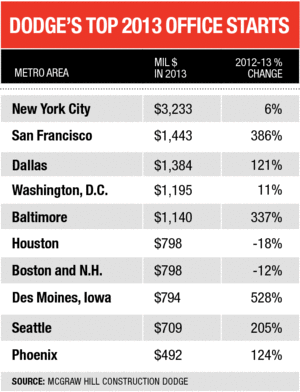

After five years of slow or no growth across many construction sectors, the technology industry's demand for new building stands out. While most markets are only gradually digging their way toward recovery, office starts in many regions are taking off, thanks in part to tech firms seeking more space for operations such as administration and data storage.
Much of the office activity is occurring in well-known tech hot spots, such as Seattle, where Amazon is building a 3.3-million-sq-ft new headquarters campus that consumes three downtown city blocks. In 2013, the city's office starts soared to $709 million, up 205% year-over-year, according to the latest revised data from McGraw Hill Construction Dodge (see table).
Analysts attribute most of the increase to Amazon's massive, three-phased project, dubbed Rufus 2.0, which includes three interconnected spherical glass-and-steel domes that can accommodate mature trees and plants from around the world. But Microsoft, Google and other tech firms also are building, expanding or renovating in the region.
"Office-building construction in Seattle is far ahead of [most] everyone else, largely because of Amazon and the high-tech sector," says Cliff Brewis, senior editorial operations director at Dodge, which shares the same ownership as this publication.
VIEW A TECH CONSTRUCTION DATA MAP AND GRAPHIC
Office construction is up by about 100% or more in 19 of the 75 metro regions Dodge tracks. Some are dubbed "tech pockets," which include the San Francisco region (up 386%), where Apple is about to start building its new, $2.5- billion headquarters in Cupertino; Facebook's $435-million West Campus expansion of its Menlo Park, Calif., headquarters is under way; and Samsung America is erecting a $200-million headquarters in San Jose, Calif.
Not all the office sector's growth can be attributed to the tech industry. However, Apple, Facebook and Microsoft as well as smaller dot-coms are expanding their operations and kick-starting markets in select regions.
"Typically, white-collar employment results in absorption of office space, which leads to construction demand," Brewis says. The tech firms typically build offices near major universities in cities with good transit, housing and other amenities. "There's no doubt about the fact that tech—and all the new creative work being done, the new firms being created … the wealth they are seeing—is just incredible," Brewis says. "It results in hiring and offices going up in those marketplaces where tech plays a significant role."
When the Amazons, Googles and other tech giants invest in space, it drives construction in other sectors, including housing, entertainment, retail and infrastructure development, says Kathleen Garrity, president of the Associated Builders and Contractors, western Washington chapter. That phenomenon is the case in Seattle, where housing and several other sectors are on the rise, she adds.
However, current construction data reflects the aftermath of the recession, which slashed office activity nationwide in 2012. The downturn largely accounts for the huge percentage upticks in office construction as regions recover. Although Seattle's office sector went through the roof last year, it probably won't sustain that growth as space demands are met, says Brewis. This trend will be the case for other regions, too, he notes.
Also, office activity in New York City—which is aiming to reclaim its late-1990s nickname of "Silicon Alley"—and other major metro areas is driven by many industries, not just tech. These regions have a big tech presence, so a multi- million-dollar project may not drive much of a change in the region's already formidable construction totals, Brewis adds.
The converse is also true for major metro regions, where starts fell last year, including Houston (down 18%) and Boston (down 12%). The office market in these cities—each at $798 million last year—remains substantial. It is important to remember that "growth is not always a straight line," so totals can fluctuate from year to year, Brewis says.
"Nobody's forecasting that Boston or Houston will be down. Their fundamentals are always good," Brewis says. "It's just one of those things where [a city] can't sustain what it did in the prior year, but its trend line is still going to be up." It is the more remote regions in which one big project may distort year-over-year numbers.
That is likely the case in the Des Moines, Iowa, region, where office construction alone climbed a whopping 528%, to $794 million, in 2013—the biggest office percentage gain last year.
Brewis attributes the regional increase to Facebook's 2013 groundbreaking of a $1-billion-plus data-center project in Altoona, Iowa, which recently gained approval for the second phase of construction. Google, which so far has invested about $1.1 billion on a massive data- center project in Council Bluffs, announced plans last year to invest another $400 million. Microsoft recently announced plans to invest $1.1 billion in a West Des Moines data-center project.
Site selection for these centers is also heavily dependent on state and local incentive packages. Iowa, which has been aggressively competing for tech-firm investments, was able to lure Facebook with $18 million in tax breaks as well as other state and local financial inducements. The firm says the center, targeted for completion next year, is slated to run 100% of its operations by wind power.
The deal "further solidifies Iowa's position as a destination for tech companies, from major data-center operations like Facebook's to the innovative start-ups we continue to see popping up around our state," said Iowa Gov. Terry Branstad in a statement last year announcing the project. "Our productive workforce and our overall cost of doing business help us to win great projects like this."
Nebraska, where Fidelity Investment Properties chose the town of Papillon to build a $200-million data center, is among the states vying with Iowa and other regions for tech dollars by offering big incentives. The Fidelity deal helps the state set the bar for other companies that are weighing location considerations for future data-center projects, said Nebraska Gov. Dave Heineman in late 2012, when the project was announced.
The competition for data-center work also is growing, such as along the southern New Jersey-to-Delaware corridor, considered one of the latest hot spots for new developments, says Rick Whitney, president and CEO of M+W U.S., Inc., whose work includes data centers.
Regions in which these facilities are located require hard investments in reliable power and water infrastructure. "The single-biggest cost is electricity," he says.
He expects that more new data-center projects by major firms likely will be announced in this region over the next 12 to 18 months but would not elaborate.
For firms that specialize in data-center construction, especially designing efficient HVAC systems to keep the servers running cool, business is good, for now.


Post a comment to this article
Report Abusive Comment